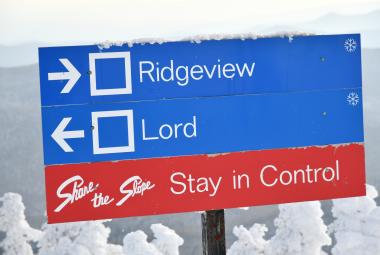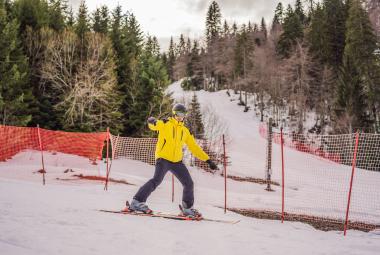Skiing is a thrilling and exhilarating sport that offers a unique way to explore the great outdoors and enjoy the beauty of winter. Whether you're looking for an adrenaline rush or simply a fun way to stay active, skiing is a great option.
However, as a complete beginner, the idea of hitting the slopes can be daunting. With this guide, you'll learn the essential techniques, tips, and common mistakes to help you make your first moves on the skis with confidence and ease.
Keep reading to learn the knowledge and skills needed to navigate the mountain, improve your technique, and have a great time skiing!
Top Tips For Your First Day

Consider Lessons
Even if you have skied before, taking a ski lesson from a certified instructor can be incredibly helpful. They can teach you proper technique, help you build confidence, and give you tips for navigating the mountain.
Plus, they are able to give you feedback and corrections you won’t be able to learn on your own.
Dress Appropriately

Make sure you have the right clothing and gear to stay warm, dry, and comfortable on the slopes or you could have a miserable and short ski day.
Layering is important, and you should have waterproof pants and jacket, gloves or mittens, a hat or helmet, and goggles or sunglasses to protect your eyes from the sun and snow.
Read more: How To Adapt To Changing Weather Conditions While Skiing
Relax and Have Fun

Ask questions when you have them, absorb as much information as possible, and give it your best effort. All you can do is your best. Keep your body relaxed and your mind focused.
After that point, don’t forget to be present in the moment and just have fun!
How To Glide On Skis

Gliding on skis is an essential technique for skiing, and it's one of the first things that you will learn as a beginner. Here are the basic steps to help you glide on skis:
- Begin by standing in an athletic stance with your feet shoulder-width apart and your knees slightly bent. Keep your hips facing forward and your weight centered over your feet.
- Point your toes straight ahead and keep your shoulders, hips, and skis in line.
- Slowly shift your weight onto one ski by gently tipping it onto its edge. This will cause the ski to start sliding forward.
- As the ski begins to glide, shift your weight onto the opposite ski by tipping it onto its edge as well. This will cause the opposite ski to start gliding forward.
- As you shift your weight back and forth between your skis, keep your upper body facing forward and your hips facing downhill. Avoid twisting your upper body or leaning too far forward or backward.
Practice gliding at a slow and controlled pace, and focus on maintaining your balance and keeping your skis parallel.
As you improve, you can gradually increase your speed and try gliding on steeper terrain. It's important to practice on flat or gentle terrain at first and have a proper equipment fit and proper boots to help you control your skis as you glide.
How To Stop On Skis

The snow plow is a basic but crucial technique for stopping on skis, particularly for beginners. It involves using the skis to create a V shape, which helps to slow down and stop. Here's how to do it:
To start the snow plow, you will need to stand in an athletic stance with your feet shoulder-width apart and your knees slightly bent.
Keep your hips facing forward and your weight centered over your feet. As you start to move, slowly bring the tips of your skis together and point them towards each other, creating a V shape. This will slow down your speed and increase friction between your skis and the snow.

As you feel yourself slowing down, you can gradually decrease the size of the V shape until you come to a stop.
It's important to keep your upper body facing forward and your weight centered over your feet as you perform the snow plow.
Avoid twisting your upper body or leaning too far forward or backward, as this can cause you to lose balance. To improve your control, you can also use your poles to help you maintain balance and control as you stop.
How To Turn On Skis

Turning on skis is an essential technique that can be challenging for beginners. However, with a few basic tips, you can start turning on skis on your very first day. Here's how:
- Start by gliding on skis in a straight line, focusing on maintaining your balance and control.
- To initiate a turn, gently shift your weight onto the inside edge of one ski. This will cause the ski to start turning in that direction.
- As the ski turns, use your upper body to help guide the turn. Look in the direction you want to turn, and use your arms and poles to help point you in that direction.
- Once the turn is complete, shift your weight back to the center of your skis and regain your balance.
- Repeat the process on the opposite ski to turn in the other direction.
Tips For Maintaining Balance And Control On Skis

Maintaining balance and control on skis is one of the hardest things to learn in the beginning of your ski journey, but it is essential for skiing safely and having fun on the mountain.
Keep your weight centered: Your weight should be centered over your feet, rather than leaning forward or backward. Keep your hips facing forward and your knees slightly bent to help maintain your center of gravity.
Keep your upper body facing forward: It's important to keep your upper body facing forward, rather than twisting it to one side or the other. This will help you maintain balance and control over your skis.
Keep your skis parallel: Make sure to keep your skis parallel to each other, rather than allowing them to point in different directions. This will help you maintain control and make it easier to turn and stop.







